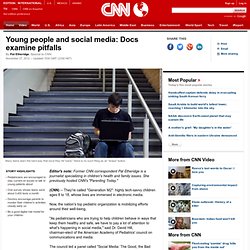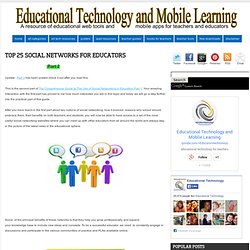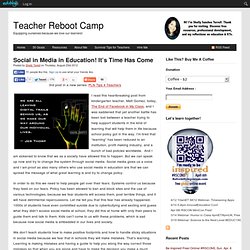

How Should Schools Navigate Student Privacy in a Social Media World? K-12 education operates in a unique position that is foreign in many ways to its higher ed counterpart.

While college kids, who are largely legally adults, are free to explore social media and experiment with new technology tools, in the K-12 environment, consideration always has to be given to student privacy when entering uncharted territories. A lot of the privacy prioritization in K-12 is legally mandated, thanks to the Family Educational Rights and Privacy Act. But FERPA was passed in 1974 in a pre-social media age. It was written to prevent schools from leaking information about students, but what happens when the students (sometimes inadvertently) are the ones doing the leaking? In a recent post, Mercer Hall and Patricia Russac from the ASIDE Blog, one of 50 Must-Read K-12 IT Blogs selected by EdTech, highlight cartoon avatars and screen names as a way to allow personalization but veil actual identity.
Want to Flip Communication? Click Here - Finding Common Ground. Flipping communication isn't about replacing anything...it's about enhancing it.

Parents cannot always make it to the PTA meetings or night events. Some of them work... Is your school’s “digital citizenship” practice a pass or fail? Cc licensed ( BY ) flickr photo shared by Walmart Corporate This past week, I worked with a small group of educators on becoming a “Networked Educator“, and we had some great conversations about how social media is changing a lot of what we do in schools.

Within the group, there were about four teachers from one high school, who came to learn together and asked questions about how they could move their school to the “next level” in how they are sharing and learning with not only each other, but students as well. They told me that felt that they were in some ways behind as a school, but they were making progress. One of the ways that they felt they were making progress was by having a school Twitter account to share what is happening at with their community. Chicago Public Schools : Social Media Toolkit. Turn Your Blog Into an eBook With Ebook Glue. Ebook Glue is a neat service that I discovered on Lifehacker this evening.

Ebook Glue allows you to create an ebook from your blog posts. To use the service just enter your blog's RSS Feed or your blog's URL if you don't know the address of your feed and Ebook Glue will turn your posts into an ePub and Mobi files for you to download, read, and distribute. I gave Ebook Glue a try with my new iPad Apps for School blog's feed and it did exactly what it advertises.
I was able to type in my blog's URL, select ePub, and then download an ePub of the blog entries. 7161689001_827164769d_b.jpg 358×1,024 pixels. Texting In The Classroom: 3 Tools To Do It Right. Whether you teacher teenagers or five-year-olds, keeping in touch with students and/or their parents is often on a teacher’s to-do list. Gone are the days of sending home hand-written and photocopied notes to parents, this is 2013. Young people and social media: Docs examine pitfalls.
Many teens learn the hard way that once they hit "send," there is no such thing as an "erase" button.

Five-Minute Film Festival: Twitter in Education. I think it's fair to say that Twitter can no longer be dismissed as a trivial passing fad.

Though I had dabbled with a personal account, my entire opinion changed when I started my @VideoAmy account and dove in to the conversations educators were engaged in. While some people certainly do tweet about what they're having for breakfast, teachers, administrators, and educational organizations use Twitter in a whole different way -- making smart use of those 140 characters to share resources, wisdom, and inspiration. With the wealth of information out there, you have to cut through the noise a little to figure out how it will work best for you. PLN-building? The Teacher’s Quick Guide To Educational Twitter Hashtags. The Teacher’s Quick Guide To Educational Twitter Hashtags Added by Jeff Dunn on 2012-10-18 I heart Twitter. If you haven’t yet, follow @edudemic to keep up with what we’re doing, working on, and seeing (like last night’s tech event with GDGT in downtown Boston!).
Social Media in Education For Beginners. The following post contains information I am sharing at the BCPVPA Connected Leaders Conference on October 19th and 20th.

As we venture into the world of social media, please remember you do NOT have to figure it out on your own, nor do you need to feel pressure throughout your immersion into the online world. Take it slow, do what feels comfortable for you, and don’t be afraid to ask colleagues for help!! There are many different forms of social media, but we will focus on the following during our time together today: Giving Every Student a Voice Through Online Discussion. How To Best Use Social Media In The Classroom. In today’s world, technology is ever changing – this is also true in education.

The prominence of social media in everyday life has also had an impact in the classroom. There are a number of different ways that social media is being used by teachers across the country. Embrace Community One major way that social media can be used in education is by using it to exchange ideas with teachers nearby and miles away. With social media, educators from across the country can connect and discuss different teaching methods and tools.
Bringing The World Into The Classroom Many schools are reaching out to the idea of incorporating technology into teaching. Social media is also a great way to keep the community feel of the school going. Top 25 Social Networks for Educators. Part 2 Update : Part 3 has been posted check it out after you read this.

This is the second part of The Comprehesive Guide to The Use of Social Networking in Education Part 1. Your amazing interaction with the first part has proved to me how much interested you are in this topic and today we will go a step further into the practical part of this guide. After you have learnt in the first part about key notions of social networking, how it evolved, reasons why school should embrace them, their benefits on both teachers and students, you will now be able to have access to a set of the most useful social networking websites where you can meet up with other educators from all around the world and always stay in the picture of the latest news in the educational sphere.
Some of the principal benefits of these networks is that they help you grow professionally and expand your knowledge base to include new ideas and concepts. 1- Classroom 2.0 Teaching in the digital age. Social in Media in Education! It’s Time Has Come. Posted by Shelly Terrell on Thursday, August 23rd 2012 3rd post in a new series: PLN Tips 4 Teachers I read this heartbreaking post from kindergarten teacher, Matt Gomez, today, The End of Facebook in My Class, and I was saddened that yet another battle has been lost between a teacher trying to help support students in the kind of learning that will help them in life because school policy got in the way.

I’m tired that “learning” has been reduced to an institution, profit making industry, and a bunch of bad policies worldwide. Five-Minute Film Festival: Pinterest for Teaching and Learning. It's easy to be jaded when there's buzz about a new social network. Who has time to keep up with them all? And how many will explode on the scene with a bang, the hottest new thing, and then fizzle like Friendster? But I have to say that the eye-candy on the visual social bookmarking site Pinterest has caught my attention. The striking, clean visuals and the bulletin board model are sure to appeal to educators, and it certainly has value as a curation tool -- a digital way to save and organize all those little bits of goodness you find online.
Rewards of teaching young children to blog SmartBlogs. I have been an elementary-school teacher for more than 25 years and I am always on the lookout for meaningful ways to engage and motivate my young students. I started Mrs. Yollis’ Classroom Blog in 2008 with the idea of sharing class activities with parents. Over time, the blog has grown to be the centerpiece of our third-grade classroom. It has become a true global learning community that offers myriad rewards for students, parents and teachers. Develop quality literacy skills When I first started blogging, I thought the posts would be the primary focus of the blog. Top 100 Tools for the Twittering Teacher. Posted on Thursday April 2, 2009 by Staff Writers By Donna Scott Twitter has become a powerful tool for community organizers, marketers, and others who want to share and receive information in a fast, friendly environment. It’s no wonder, then, that some of the best online colleges teachers have also found success on Twitter, using the tool to connect with students, share information with parents, and find useful resources.
Here, we’ll take a look at 100 tools that can help twittering teachers make the most out of this helpful microblogging tool. Note: We’ve updated this list for 2012 with even more useful, up-to-date tools for savvy educators. The challenges facing social media for kids. Keeping kids safe online is becoming increasingly tricky with social media playing a larger role in everyday life for most Web users.
At the recent Amplify event for woman-led startups, I met up with Hilary DeCesare, the CEO and co-founder of Everloop. 25 Ways Teachers Can Integrate Social Media Into Education. Social Media: Guidelines for School Administrators. Social media tools like Facebook, Myspace, Instagram, Google+ and Flickr are potentially exciting learning and teaching tools that can help teachers and students make connections to ideas, skills and concepts in a 21st-century learning environment.
However, social media are getting a bad rap in education. Some students use the tools in ways that pit their First Amendment rights against their responsibilities as students in brick-and-mortar schools. In 2006, the American Civil Liberties Union filed suit against the Hermitage School District in Pennsylvania after the district suspended student Justin Layshock for creating an unflattering online parody of his principal. In 2007, a federal judge determined that the suspension was unconstitutional, and in 2010, a three-judge panel of the Third Circuit Court of Appeals ruled that the district violated the student’s First Amendment rights. Clearly, schools must consider the rights of students to freedom of expression.